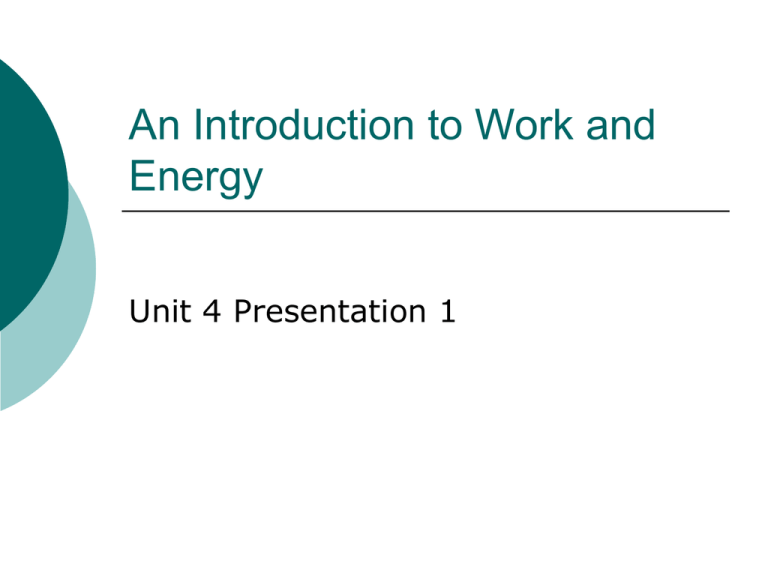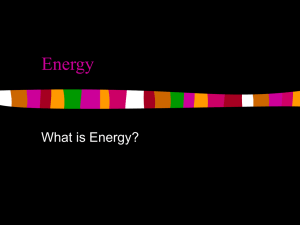An Introduction to Work and Energy
advertisement

An Introduction to Work and Energy Unit 4 Presentation 1 What is Work? Work is defined as a force applied over a distance Work is a scalar W F dll Note that the distance must be parallel to the applied force kg m 2 J SI Unit: Joule 2 s Work Examples Calculate the work it takes to lift a 50N box 3 meters. W ? F 50N d 3m W F d 50N (3m) 150J Calculate the work it takes to lift a 20 kg box 5 meters. W ? F 20kg (9.8m / s 2 ) 196N d 5m W F d 196N (5m) 980J Non-aligned forces Remember, the applied force MUST be in the same direction of the motion to calculate work. If not, consider the following: Consider the applied force vector: Force applied, through tension in a rope Fap q Fll F Fll Fap cosq Motion of the block Therefore, work can also be described as: W ( Fap cosq ) dll What is Energy? Energy is defined as the ability to do work. If an object has energy, it has an ability to do work, which is a force applied over a distance. 6 Main Types of Energy Heat Sound Light Chemical Electrical Mechanical (Kinetic & Potential) Mechanical Energy Mechanical Energy is divided into Kinetic Energy and Potential Energy Kinetic Energy: The Energy of Motion Potential Energy: Stored Energy that can be converted into other types of energy Work – Kinetic Energy Theorem Theorem: The net work done on an object is equal to the change in the object’s kinetic energy. W KE f KEo KE Kinetic energy is the energy of motion of an object: 1 2 KE mv 2 SI Unit for Energy: Joule Kinetic Energy Example The driver of a 1000 kg car traveling on the interstate at 35.0 m/s (nearly 80 mph) slams on his breaks to avoid hitting a second vehicle in front of him, which had come to rest because of congestion ahead. After the breaks are applied, a constant friction force of 8000 N acts on the car. Ignore air resistance. (a) At what minimum distance should the breaks be applied to avoid a collision with the other vehicle? (b) If the distance between the vehicles is initially only 30 m, at what speed would the collision occur? Kinetic Energy Example Lets apply the Work-Kinetic Energy theorem: W 1 2 1 2 mv f mv o 2 2 Now, consider that the only work being done is by kinetic friction, and the force and direction of motion are opposite of each other: 1 1 f k 8000N d ? m 1000kg vo 35m / s v f 0m / s fk d mv 2f mv o2 2 2 1 2 1 2 m vf m vo 2 d 2 fk 1 1 (1000)(02 ) (1000)(352 ) 2 d2 76.6m 8000 Kinetic Energy Example Now, find the speed at impact if the distance is only 30 m. f k 8000N d 30m m 1000kg vo 35m / s vf ? 1 2 1 2 f k d mv f mv o 2 2 1 f k d m vo2 2 vf 1 m 2 1 8000 30 (1000)(352 ) 2 v f 27.3m / s 1 (1000) 2 Conservative and Nonconservative Forces Conservative Force: A force that allows a user to recover their work, as kinetic energy, completely and with very little dissipation. Nonconservative Force: A force that does not allow a user to recover their work, as kinetic energy, very well. In fact, much of the work is dissipated as various other forms of energy (heat, sound, etc.) Gravitational Potential Energy Work can be done on a system to raise its level of energy without giving it kinetic energy. Ex: Lifting a brick from the floor to a tabletop. Work was done against the force of gravity, and the brick is said to have gravitational potential energy. Gravitational Potential Energy U m gh h height U = Potential Energy SI Units: Joule Gravitational Potential Energy Example Calculate the change in gravitational potential energy when a 5 kg brick is lifted 20 meters above ground level. m 5kg g 9.8m / s h 20m U ? 2 U mgh U 5kg(9.8m / s 2 )(20m) 980J Conservation of Energy Energy can be neither created nor destroyed in any type of reaction, physical or chemical. Rather, energy simply changes form. Conservation of Mechanical Energy In any isolated system of objects interacting only through conservative forces, the total mechanical energy E = KE + GPE, of the system, remains the same at all times. Conservation of Mechanical Energy Mathematically Eo E f KEo GPEo KE f GPE f 1 2 1 2 m vo m gho m vf m ghf 2 2








